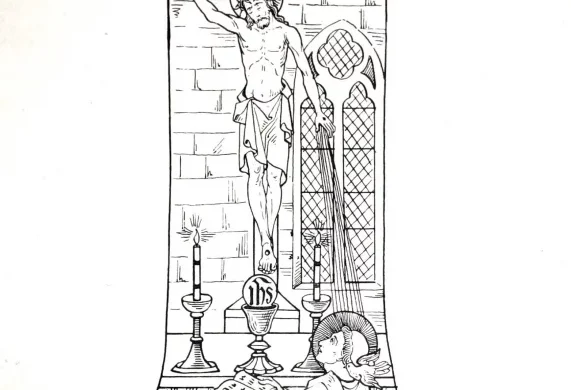
The Story of St. Hubert: From Noble Hunter to Patron Saint
Once a wealthy nobleman, St. Hubert’s life changed forever after a divine vision of a stag with a glowing cross. This powerful moment led him to a life of faith, humility, and service.
In Christian belief, a saint is a holy person who lived by Jesus Christ’s teachings. As Christians, we recognize their contributions to the faith, and seek their intercession and guidance in our daily life.
On special holidays, Christians remember and celebrate the lives of these holy individuals. They attend Mass, participate in prayer services and processions, and read inspiring stories of the saints. This serves as a time to reflect on the virtues and values these saints embodied, such as love, compassion, humility, and selflessness.
Honoring Christian Saints reminds us Christians to live a life of faith and service to others. The lives of these holy individuals inspire all Christians to lead lives of holiness and devotion to God. As they continue to inspire and guide us in our spiritual journeys, we may also truly understand that the true essence of these celebrations is to honor our God and follow Jesus Christ’s teachings.

Once a wealthy nobleman, St. Hubert’s life changed forever after a divine vision of a stag with a glowing cross. This powerful moment led him to a life of faith, humility, and service.

What would inspire a 12-year-old boy to risk his life in ancient Rome? Discover the story of Saint Tarcisius, who chose death rather than surrender the Eucharist, and learn why his courage continues to inspire Christians today.

With unshakeable faith and a powerful pen, St. Catherine of Siena dared to challenge the Pope. Her bold letters sparked a historic change, returning the papacy to Rome.

Discover the extraordinary story of a young mother whose final act of courage transformed a moment of execution into an eternal testament of faith. In ancient Carthage, facing death itself, Perpetua showed us what it means to have faith beyond fear.

When Attila the Hun threatened Rome in 452 AD, Pope Leo the Great faced him armed with only faith and diplomacy. Against all odds, he convinced history’s most feared conqueror to retreat. This extraordinary encounter, combined with his profound influence on Christian doctrine and papal authority, transformed both Rome and the Church forever.

Saint Benedict of Nursia, born around 480 AD, made a big impact on Western history. During the fall of the Roman Empire, he created the Benedictine Rule—a guide for living a balanced life with prayer, work, and study. His Rule focused on stability and obedience as ways to find true freedom and spiritual growth. Saint Benedict’s teachings remind us of the importance of living with purpose and order.

San Roque, also known as Saint Roch, was a French saint born around 1295 who dedicated his life to healing the sick during the plague. He is remembered for his miraculous healing powers, humble pilgrimages, and divine assistance from a dog when he fell ill. San Roque’s feast day on August 16th celebrates his legacy of compassion, faith, and service, reminding us to care for others, maintain resilience in the face of adversity, and selflessly serve our communities

The Feast of St. John the Baptist, celebrated on June 24th, honors his role in preparing the way for Jesus. John emphasized repentance, courage, and humility. Theologians like St. Augustine and Thomas Merton highlight his significance in transitioning from the Old to the New Testament and the importance of solitude and prayer. John’s example inspires us to live with courage, humility, and a call to repentance.

Anthony of Padua, born in 1195 in Lisbon, Portugal, is a beloved Catholic saint known for his powerful preaching and deep scriptural knowledge. Initially an Augustinian, he joined the Franciscan Order and preached across Italy and France. Celebrated on June 13, he is the patron saint of lost items and is revered for his compassion, humility, and devotion to the poor. His life exemplifies faith, perseverance, and service, inspiring modern believers to trust in God’s plan and show compassion to others.

Saint Thomas Aquinas is most well-known as a theologian with two specific masterpieces, the Summa Contra Gentiles and the Summa Theologiae. He was also well known as a poet, penning several eucharistic hymns. Considered the greatest of the Scholastic philosophers, Thomas’ writings provided a comprehensive synthesis of Christian theology and Aristotelian philosophy.

The Saint Andrew Christmas Novena Prayer. This is a beautiful prayer about the birth of Christ that can serve as a meditation for Advent. The Saint Andrew Christmas Novena Prayer is customarily prayed up to fifteen times daily from November 30th until Christmas Day.

Lutherans and Roman Catholics celebrated the feast days of St. Philip and St. James the Apostles on May 1st and 3rd. Both church bodies agree on the importance of these Apostles. Philip was called by Jesus in Bethsaida and brought Nathanael to Christ, while St. James is traditionally believed to have been martyred. Ecclesiastical Sewing has introduced “The Apostle Collection” of church vestments, emphasizing these important figures in Christian history.
Today we give thanks for the life of Saint Damasus I. He was Bishop of Rome from 366 A.D. to 384 A.D. During this period, Christianity was declared the official religion, Latin became the official language of the Church (as opposed to Greek), & Saint Damasus encouraged Jerome to translate the Bible into Latin.

St. Anselm, born around 1033 A.D. in northern Italy, later part of the Kingdom of Burgundy, journeyed to Normandy in 1059. Influenced by Lafranc of Pavia, Anselm became the Abbot of Bec in 1078 and transformed it into a center of learning. A skilled administrator, he later succeeded Lafranc as the Archbishop of Canterbury in 1093. Anselm’s contributions extended to philosophy and theology, making him a notable figure in medieval history.

St. Urho’s Day, celebrated on March 16th, the day before the better-known feast of some minor saint from Ireland, who was alleged to have driven the snakes from the island.
You must be logged in to post a comment.